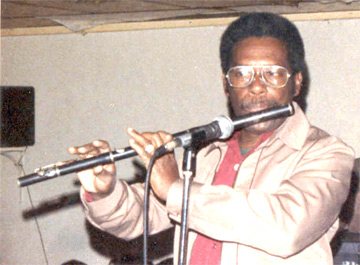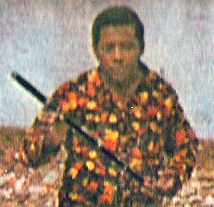Indice - Table of contents
New Stuff[hide]
Reportes: From The St... : Cubadisco 2...
Fotos: Tom Ehrlich
Staff: Kristina Lim
Musicos: Juan Formell
Musicos: Yordamis Megret Planes
Musicos: Yasser Morejón Pino
Musicos: José Luis "Changuito" Quintana...
Musicos: Dennis Nicles Cobas
Fotos: Eli Silva
Grupos: Ritmo Oriental : 1988 - Vol. IX - 30 a...
Musicos: Rafael Paseiro Monzón
Musicos: Jiovanni Cofiño Sánchez
Fotos: Tom Ehrlich : 2024 Monterey Jazz, P...
Resenas: Vacilón Santiaguero (Circle 9 ...
Photos of the Day [hide]
The Music of Ritmo Oriental - Polo Tamayo
Policarpo "Polo" Tamayo

Polo Tamayo - 1986 - Mexico City - photo by Victor Barrientos
I'm far from an expert on charanga, (and I'm sure I'll be hearing from readers who are), but from what I have heard, it's hard to imagine that anyone could top Ritmo Oriental's flautist, "Polo" Tamayo. Aragón's Richard Egües probably has the purest and most beautiful tone, and most elegant phrasing, but Polo's funky, humorous and quick-witted ideas complement the style of la Ritmo in the most perfect way imaginable.
 Almost all of the tracks we've studied could be used to highlight Polo's contributions, but his first solo on María baila el son is particularly interesting, recalling Charlie Parker in the way he humorously takes an old song (When the Red Red Robin Comes Bob Bob Bobbin' Along) and turns it on its ear by displacing it rhythmically.
Almost all of the tracks we've studied could be used to highlight Polo's contributions, but his first solo on María baila el son is particularly interesting, recalling Charlie Parker in the way he humorously takes an old song (When the Red Red Robin Comes Bob Bob Bobbin' Along) and turns it on its ear by displacing it rhythmically.
Polo's solo also contains an interesting section where the piano tumbao switches to all offbeats. I'm still looking for the name of Ritmo Oriental's pianist (subliminal message: write EGREM!).
The cuerpo arrangement of María baila el son creates a beautiful and mysterious mood which showcases several unusual instances of Ritmo Oriental's pattented con efecto technique:
introduction:
xxxx xxxx xxxx TxTx (percussion intro - T=tom)
xxxx xxxx xxx0 0x0x (0=bass)
0xxx xxxx xxxx 0x0x
0xxx xxxx xxxS SxBx (S=strings, 0=bass - very slight con efecto)
xxxS SxBx xxxS SxBx (heavy con efecto begins on underlined note)
xxxx xxxx xxxx VxVx (V=lead vocalist - Marí ...)
0x0x xxxx xxx0 0x0x (0=bass, in tempo)
0x0x xxxx xxx0 0xxx (con efecto begins on underlined note)
BBxB BxBB BCxC xCCC (C=coro - María baile el ...)
While it doesn't use con efecto, the transition from the cuerpo to the montuno section is the highlight of the track. The percussionists take turns alternating with the bass in filling the 3-side of each clave while the güiro keeps time, but Lazaga almost steals the show. His basic part is a variation of contracampana (0x0x 0000 x000 0x00), but listen to the way he gets in and out of an all-offbeat pattern during the fourth and fifth claves:
güiro part for transition
0x0x 0000 x000 x000
0x0x 0000 x000 x000
0x0x 0000 x000 x000
x0x0 x0x0 x0x0 x0x0
x0x0 x0x0 x0x0 x00x
0x0x 0000 x000 x000
0x0x 0000 x000 x000
0x0x 0000 x000 x00x
1974 Ritmo Oriental- La señora perorata (J. C. Maza)
xx0x 0xxx 0xx0 xxx0 2-3 rumba clave
xxxx xxxx xxx0 xx0x (bass pickups)
xxx0 xx0x xxx0 xx0x
x0x0 0x0x xxx0 xx0x bass - MIDI example
bass: Humberto Perera
source: La historia de la Ritmo, Vol. 1
notes: This is the third tumbao from this session that's based on bombo-ponche. Humberto adds a catchy figure every other time to extend the tumbao to 2 claves.
The "rapped" verse of the cuerpo predates Charanga Habanera and Manolín by about 20 years, and the overdubbed female voice (Señora perorata translates to "long-winded lady") was first utilized by CH in Quítate el disfraz (source) and later parodied outright (in drag) in Yuya la charanguera (source).In-between is a melodic chorus featuring one of Juan Crespo's Maza's most addictive hooks.





















